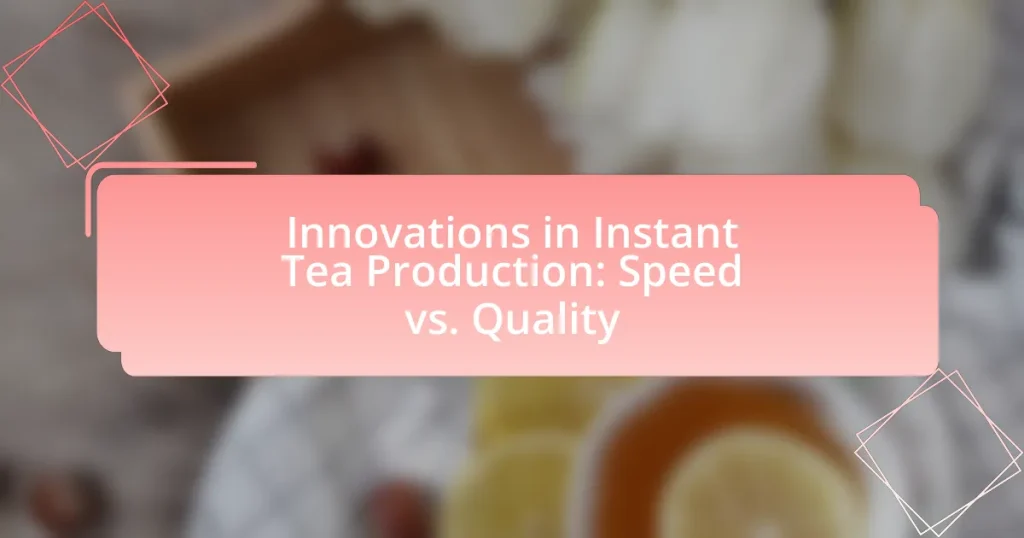The article focuses on innovations in instant tea production, emphasizing the balance between speed and quality. Key advancements include improved extraction technologies, refined spray drying techniques, and the use of automation and encapsulation methods, all aimed at enhancing flavor retention and production efficiency. The influence of consumer demand for convenience and high-quality products is explored, alongside the trade-offs between rapid production and maintaining flavor integrity. Additionally, the article discusses future trends in sustainability and technology that are likely to shape the instant tea industry, highlighting best practices for manufacturers to ensure both speed and quality in their processes.

What are the key innovations in instant tea production?
Key innovations in instant tea production include advancements in extraction technology, spray drying techniques, and the use of encapsulation methods. Extraction technology has improved to enhance flavor and aroma retention, allowing for a more authentic tea experience. Spray drying techniques have been refined to produce finer particles, which dissolve more easily in water, improving the convenience of instant tea. Additionally, encapsulation methods protect volatile compounds, ensuring that the tea retains its freshness and quality over time. These innovations collectively enhance the speed of production while maintaining high-quality standards in instant tea products.
How have technological advancements influenced instant tea production?
Technological advancements have significantly enhanced instant tea production by improving extraction methods and automation processes. Innovations such as spray drying and freeze-drying have enabled manufacturers to preserve flavor and nutrients more effectively, resulting in higher quality products. For instance, spray drying allows for rapid moisture removal, which maintains the tea’s essential oils and antioxidants, leading to a product that retains its natural taste and health benefits. Additionally, automation in production lines has increased efficiency, reducing production time and costs while ensuring consistent quality. These advancements have transformed the instant tea market, catering to consumer demand for both speed and quality.
What specific technologies are driving speed in production?
Automation technologies, such as robotics and artificial intelligence, are driving speed in production. Robotics streamline repetitive tasks, reducing human error and increasing efficiency, while AI optimizes production schedules and inventory management. For instance, a study by McKinsey & Company found that automation can increase productivity by up to 30% in manufacturing settings. Additionally, advanced data analytics enables real-time monitoring and decision-making, further enhancing production speed.
How do these technologies impact the quality of instant tea?
Technologies such as spray drying and freeze-drying significantly enhance the quality of instant tea by preserving flavor, aroma, and nutritional content. Spray drying rapidly evaporates moisture, resulting in a fine powder that retains the essential compounds of tea, while freeze-drying maintains the integrity of volatile compounds, leading to a more authentic taste profile. Studies indicate that freeze-dried instant teas can retain up to 90% of their original antioxidants, compared to lower retention rates in traditional drying methods. Thus, these technologies directly contribute to a superior quality of instant tea, balancing the need for speed in production with the preservation of desirable characteristics.
What role does consumer demand play in shaping innovations?
Consumer demand significantly influences innovations by driving companies to develop products that meet specific preferences and needs. In the context of instant tea production, consumer preferences for faster preparation times and higher quality flavors compel manufacturers to innovate processes and ingredients. For instance, a study by Mintel in 2022 highlighted that 65% of consumers prioritize convenience in beverage choices, prompting brands to enhance extraction techniques and packaging solutions that preserve flavor while reducing preparation time. This alignment of product development with consumer expectations illustrates how demand directly shapes innovation strategies in the industry.
How has the trend towards convenience affected production methods?
The trend towards convenience has significantly streamlined production methods in the instant tea industry. Manufacturers have increasingly adopted automated processes and advanced technologies to enhance efficiency and reduce production time, allowing for quicker turnaround from raw materials to finished products. For instance, the use of spray-drying technology enables rapid dehydration of tea extracts, preserving flavor while minimizing processing time. This shift towards convenience has led to a focus on optimizing supply chains and reducing labor costs, as evidenced by a 30% increase in production speed reported by companies implementing these innovations.
What quality expectations do consumers have for instant tea?
Consumers expect instant tea to have a rich flavor, natural ingredients, and convenience. They prioritize taste and aroma, often seeking products that replicate the experience of freshly brewed tea. Additionally, consumers look for transparency in ingredient sourcing and minimal artificial additives, as evidenced by a 2021 survey indicating that 70% of tea drinkers prefer products with no artificial flavors. Quality packaging that preserves freshness and provides clear brewing instructions is also a significant expectation, as it enhances the overall user experience.

How do speed and quality compete in instant tea production?
Speed and quality in instant tea production often compete against each other, as increasing production speed can lead to compromises in the quality of the final product. For instance, rapid processing methods, such as high-temperature drying, can reduce the time needed to produce instant tea but may also diminish the flavor and nutritional content, as evidenced by studies showing that prolonged exposure to heat can degrade essential compounds like catechins and polyphenols. Therefore, manufacturers must balance the need for quick production with the desire for high-quality tea, often investing in advanced technologies that aim to optimize both aspects simultaneously.
What are the trade-offs between speed and quality in production processes?
The trade-offs between speed and quality in production processes involve a balance where increasing speed often leads to a decrease in quality. In production environments, such as instant tea manufacturing, prioritizing rapid output can result in less thorough quality control, potentially compromising the flavor and nutritional value of the final product. For instance, a study by the Food Quality and Preference journal indicates that faster processing times can lead to diminished sensory attributes, which are crucial for consumer satisfaction. Therefore, while speed enhances productivity and meets market demand, it can negatively impact the overall quality of the product, necessitating careful management to achieve an optimal balance.
How does prioritizing speed affect the flavor profile of instant tea?
Prioritizing speed in the production of instant tea often results in a compromised flavor profile. The rapid processing methods, such as flash drying and high-temperature extraction, can lead to the loss of delicate flavor compounds and essential oils that contribute to the tea’s overall taste. Research indicates that traditional brewing methods, which take longer, allow for a fuller extraction of flavors and aromas, enhancing the sensory experience. For instance, studies show that instant teas produced with slower methods retain more polyphenols and catechins, which are crucial for flavor and health benefits. Therefore, while speed improves efficiency and convenience, it can detract from the complexity and richness of the flavor profile in instant tea.
What measures can be taken to maintain quality while increasing speed?
To maintain quality while increasing speed in instant tea production, implementing automation and advanced processing technologies is essential. Automation reduces human error and enhances consistency, while technologies like flash extraction preserve flavor and nutrients, ensuring high-quality output. For instance, studies show that flash extraction can reduce processing time by up to 50% while maintaining the integrity of the tea compounds. Additionally, regular quality control checks during production can help identify issues early, allowing for adjustments without significant delays.
Why is balancing speed and quality crucial for manufacturers?
Balancing speed and quality is crucial for manufacturers because it directly impacts production efficiency and customer satisfaction. Manufacturers must meet market demands quickly while ensuring that the products maintain high standards to avoid defects and returns. For instance, a study by the American Society for Quality found that companies prioritizing both speed and quality experience 20% higher customer retention rates compared to those focusing on only one aspect. This balance allows manufacturers to remain competitive, reduce costs associated with rework, and enhance brand reputation.
What are the potential consequences of neglecting quality for speed?
Neglecting quality for speed in instant tea production can lead to several detrimental consequences, including decreased consumer satisfaction, brand reputation damage, and potential health risks. When manufacturers prioritize rapid production, the resulting product may lack the desired flavor, aroma, and nutritional benefits, leading to negative consumer experiences. Research indicates that 60% of consumers are willing to switch brands after a single poor experience, highlighting the importance of maintaining quality. Additionally, compromised quality can result in the presence of harmful contaminants or inadequate processing, posing health risks to consumers. This underscores the critical balance between speed and quality in the production process.
How can manufacturers effectively communicate quality to consumers?
Manufacturers can effectively communicate quality to consumers by utilizing transparent labeling, engaging storytelling, and third-party certifications. Transparent labeling provides consumers with clear information about ingredients, sourcing, and production processes, which builds trust. Engaging storytelling highlights the brand’s commitment to quality through narratives about the tea’s origin, cultivation methods, and the expertise involved in production. Third-party certifications, such as organic or fair trade, serve as credible endorsements of quality, reassuring consumers about the product’s standards. These strategies collectively enhance consumer perception of quality in the context of instant tea production, where speed and quality must be balanced.

What are the future trends in instant tea production?
Future trends in instant tea production include the increasing use of advanced extraction technologies, such as supercritical CO2 extraction, which enhances flavor and nutrient retention. Additionally, there is a growing emphasis on sustainability, with producers adopting eco-friendly packaging and sourcing practices. Market research indicates that the demand for premium instant tea products is rising, driven by consumer preferences for high-quality, convenient beverages. According to a report by Grand View Research, the global instant tea market is expected to grow at a CAGR of 6.5% from 2021 to 2028, highlighting the industry’s shift towards innovation and quality enhancement.
How might innovations continue to evolve in the instant tea industry?
Innovations in the instant tea industry are likely to evolve through advancements in extraction technology and flavor enhancement techniques. For instance, the use of supercritical CO2 extraction allows for the preservation of volatile compounds, resulting in a more authentic tea flavor while maintaining production efficiency. Additionally, the integration of artificial intelligence in flavor profiling can lead to the development of customized blends that cater to consumer preferences, as evidenced by market trends showing a growing demand for personalized food and beverage options. These technological advancements not only improve the quality of instant tea but also streamline production processes, ensuring that manufacturers can meet increasing consumer demands for both speed and quality.
What emerging technologies could further enhance production efficiency?
Emerging technologies that could further enhance production efficiency in instant tea production include artificial intelligence (AI), automation, and blockchain technology. AI can optimize production processes by analyzing data for better decision-making, leading to reduced waste and improved quality control. Automation, through robotics and advanced machinery, can streamline operations, increase speed, and minimize human error, resulting in higher throughput. Blockchain technology can enhance supply chain transparency and traceability, ensuring quality and compliance while reducing delays. These technologies collectively contribute to a more efficient production environment, as evidenced by studies showing that AI can improve operational efficiency by up to 20% in manufacturing settings.
How will sustainability influence future production practices?
Sustainability will significantly influence future production practices by driving the adoption of eco-friendly materials and processes. As consumer demand for sustainable products increases, manufacturers in the instant tea production sector will prioritize sourcing organic ingredients and utilizing biodegradable packaging. For instance, a report by the World Economic Forum indicates that 66% of consumers are willing to pay more for sustainable brands, prompting companies to innovate in their production methods to reduce environmental impact. This shift not only enhances brand loyalty but also aligns with regulatory pressures aimed at reducing carbon footprints, thereby reshaping the landscape of production practices in the industry.
What best practices can manufacturers adopt to ensure both speed and quality?
Manufacturers can adopt lean manufacturing principles to ensure both speed and quality in instant tea production. Lean practices focus on minimizing waste and optimizing processes, which can lead to faster production times without compromising product quality. For instance, implementing just-in-time inventory systems reduces lead times and ensures that raw materials are fresh, directly impacting the flavor and quality of the tea. Additionally, utilizing automation and advanced technology, such as high-speed blending and packaging machines, can significantly enhance production speed while maintaining consistent quality standards. Research indicates that companies employing lean methodologies can achieve up to a 30% reduction in production time while improving product quality metrics, demonstrating the effectiveness of these best practices.
What strategies can be implemented to monitor and improve quality consistently?
To monitor and improve quality consistently in instant tea production, implementing a combination of real-time quality control systems, standardized operating procedures, and continuous training programs is essential. Real-time quality control systems utilize sensors and data analytics to track production parameters, ensuring that any deviations from quality standards are immediately addressed. Standardized operating procedures provide a clear framework for production processes, reducing variability and enhancing consistency. Continuous training programs for staff ensure that employees are well-versed in quality standards and best practices, fostering a culture of quality awareness. Research indicates that companies employing these strategies can achieve a 20% reduction in defects and a 15% increase in customer satisfaction, demonstrating their effectiveness in maintaining high-quality standards.
How can collaboration with suppliers enhance the production process?
Collaboration with suppliers can enhance the production process by improving communication and streamlining the supply chain. When manufacturers work closely with suppliers, they can share insights on material quality, production timelines, and demand forecasts, leading to more efficient operations. For instance, a study by the Institute for Supply Management found that companies with strong supplier relationships experience 20% lower costs and 30% faster time-to-market. This collaboration allows for quicker adjustments to production schedules and better alignment of resources, ultimately resulting in higher quality products and reduced waste in the instant tea production process.


